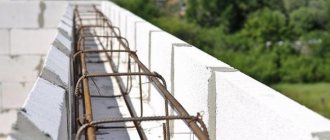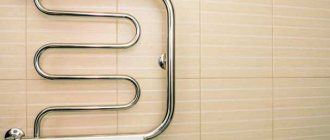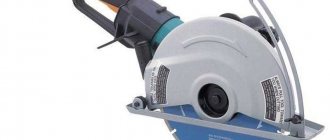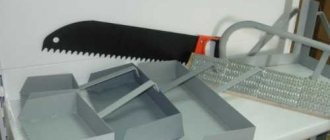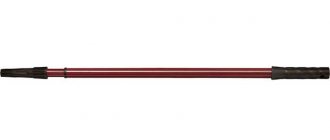Aerated concrete blocks, due to their high technical characteristics, are widely used both in individual construction and in the construction of commercial and industrial buildings. These products are made with minimal variation in geometric parameters: therefore, the masonry seam is very thin. Reinforcement, which must be done every 3-4 rows of masonry using reinforcing mesh, unjustifiably increases the thickness of the masonry joint, which negatively affects the heat-saving properties of the structure. Therefore, reinforcing bars are placed in grooves, for the manufacture of which you will need a wall chaser for aerated concrete.
You cannot do without such a device when arranging internal hidden electrical wiring, as well as when making grooves for pipelines and laying other communication networks (Internet, television cable, wired telephone, etc.).
Types of wall chasers for aerated concrete
Aerated concrete belongs to cellular concrete, its density is 4–5 times less than that of ordinary concrete. Therefore, for its processing and gating, you can use not very powerful tools (and even manual ones with success).
All devices for making grooves are divided into electric and manual. Now on sale you can find a huge variety of different electric wall chasers (single, double, multi-disc, milling) at prices ranging from 4,000 to 40,000 rubles from different manufacturers. Almost any model is suitable for cutting grooves in aerated concrete.
However, given that aerated concrete blocks are quite easy to process, many builders have come to the conclusion that a manual wall chaser for aerated concrete is quite suitable for making grooves. Manufacturers of hand tools: Petrotech, Aeroc, H+H, Remocolor, KSMI. The price for these products is quite affordable and ranges from 450 to 850 rubles. There are two types of furrow machines for working with aerated concrete:
- Hand-held devices designed for making grooves on horizontal surfaces. They have a shorter and curved handle and are designed for cutting grooves for laying reinforcing rods.
- Products designed for cutting grooves on vertical wall surfaces. These devices have a longer and straighter handle.
On a note! The division of manual wall chasers is very arbitrary; everyone chooses their own convenient tool to use.
Both types of manual wall chasers have common advantages:
- low price;
- light weight;
- simplicity of design and reliability in operation;
- minimal dust formation and noise during work;
- durability;
- energy independence (that is, they are not afraid of power outages: and this is very important in suburban construction).
Safety regulations
If you want to make such a unit yourself, you will need a lot of time, some knowledge, practice, and manufacturing instructions. Before work, weigh everything carefully: is it worth starting, will the money spent pay off? Ask your friends, other builders who have experience making similar tools, whether it is profitable.
If you have the desire, then creating a wall chaser yourself is quite possible. The main thing is to adhere to manufacturing rules and remember safety precautions.
Return to contents
Homemade wall chaser for aerated concrete
Having some plumbing skills, you can make a wall chaser for aerated concrete with your own hands without much difficulty and with little investment.
Manual wall chaser
The simplest device can be made from a piece of ordinary metal fastening perforated tape. Using a hacksaw for metal, we cut a strip 40÷45 cm long, bend it in half, form a scraper at the bend (we choose the configuration and dimensions depending on the desired width of the groove), connect the two free ends together and wrap them with several layers of electrical tape (that is, we get something like a handle), saw off the excess. We get a cheap, but quite practical wall chaser for aerated concrete blocks. Having pressed our device along the aerated concrete several times (usually no more than 4÷5), we get a neat furrow. If desired, you can make a handle, for example, from a wooden block.
A little more complicated, but a more reliable wall chaser for aerated concrete can be made with your own hands from a piece of water pipe. Manufacturing procedure:
- Using a grinder, we cut a piece 100÷120 mm long from the pipe (we select the diameter depending on the width of the required groove) at an angle of 45˚.
- We weld it to the reinforcement bar (diameter 12÷14 mm) at a right angle. If we use the rest of a water pipe as a handle, then we weld the cutting part to it at an angle of 30÷40˚.
- We bend the reinforcement in the area of the welding site at an angle convenient for gating.
Another option for making a manual wall chaser for aerated concrete with your own hands:
- We use a wood crown saw as the cutting element. Bend it using pliers into a triangle shape with rounded corners.
- A piece of water pipe is suitable for the handle. From one end, using a hacksaw, we make a cut with a depth equal to the width of the cutting blade.
- We insert the cutting workpiece into the cut, drill a hole in the pipe and the workpiece and screw a self-tapping screw into it.
On a note! Since it is quite simple to make a wall chaser for making grooves in aerated concrete, everyone can choose the design of the cutting element and the length of the handle independently.
Simple electric wall chaser for aerated concrete
The ease with which you can groove aerated concrete for wiring allows you to make a wall chaser from a regular electric drill. To do this, you will need a cylindrical cutter (average cost 450÷550 rubles), which we install in the drill chuck. This simple device allows you to make grooves in aerated concrete walls quickly and efficiently. Since a large amount of dust is generated during the work, it is better to do the gating together (the second person works with a vacuum cleaner), and also use goggles and a respirator. If desired, you can make a wooden sled into which we attach the drill. This device will allow you to make a groove of the same depth along its entire length. Although, after practicing on a block, which probably (at least one) was left after construction was completed, you can make neat grooves without complicating the design, using only a drill and a cutter.
Design and principle of operation of the furrow maker
It is not unreasonable that he resembles an angle grinder.
Some commercial examples can even be used, after reconfiguration, as an angle grinder. But there are quite a lot of differences between them. The most obvious example is engine power. This characteristic of a wall chaser is approximately 2 times higher than that of a similar angle grinder. The principle of its operation is as follows: in brick, aerated concrete, plasterboard, foam block, boards, shell rock and other consumables used in construction, an incision is made with two grooves by deepening the working disks into the material.
The circles are covered with a casing that houses a labyrinthine dust collection system. From the protection there is a pipe intended for connecting an industrial vacuum cleaner. As a result, the furrower not only cuts the material, but also ensures cleanliness during the work process.
Dust removal
Working with two diamond wheels at once creates a large amount of dust. This significantly affects the work process. Therefore, an integral part of the wall chaser casing is the presence of a pipe for dust-free work. A mandatory element when cutting channels is the presence of a construction vacuum cleaner connected to the pipe.
Here is one example of a homemade vacuum cleaner:
Branded wall chasers often come complete with vacuum cleaners. In this case, you don’t have to think about matching the technical characteristics of the power tool with the performance of the vacuum cleaner.
It is difficult to perform high-quality dust extraction in a homemade wall chaser, but it is possible. However, its significant reduction is an important step towards ensuring normal working conditions.
What to choose for grooves: glue or cement mortar
We would recommend masonry adhesive, and for the following reasons:
- Glue is easier and faster to prepare.
- The glue gains strength much faster.
- The glue consumption is two and a half times less.
- The glue contains special additives that improve adhesion.
- The glue retains water better and gains strength faster.
- Aerated concrete will quickly draw water out of the solution, and it will not have time to gain sufficient strength.
- Large grooves are increased cold bridges that are of no use.
Important recommendation! The finished groove must be cleaned of dust and moistened generously with water, then apply glue, recess the reinforcement and tighten it into the plane of the row.
Special features of the tool - how it will help us
When laying elements of engineering communications (pipelines, various cables or electrical wiring), it is often necessary to make new grooves for wires for various reasons. To cut grooves in monolithic reinforced concrete walls and ceilings, in brickwork and other materials, you can use a grinder and a hammer drill. However, modern industry does not stand still. Every day, more and more new devices are offered to the attention of professionals and amateurs to simplify construction and installation work. A wall chaser is no exception - a special tool for making channels in walls for wiring and other communications.
In terms of its operating principle and appearance, a manual wall chaser is very similar to a grinder. There are very few differences between them:
- The wall chaser makes two parallel cuts at once, since it has two cutting discs.
- Unlike a grinder, a wall chaser is equipped with a working platform, which, when a certain depth of the slot is reached, rests on the surface, preventing the hole from being deepened. This platform can adjust the depth of the groove due to its mobility.
- Some types of wall chasers are equipped with a dust removal system, which is very important for construction work.
The principle of operation of a wall chaser is as follows: when this tool is used to mark a surface, rotating diamond discs cut two parallel recesses.
Types of devices
A wall chaser is a special device designed to make grooves (furrows) on hard surfaces. Its main application is the production of grooves for further installation of electrical wiring in them. Using this tool, you can make recesses of the desired thickness and depth, while the dust emission will be minimal, especially when compared with the work of an angle grinder.
There are two types of fixture:
- electric;
- manual.
The electric device has a high operating speed and the ability to cut through strong walls even made of reinforced concrete, but at the same time it is characterized by noisy operation, a large amount of dust generated (a vacuum cleaner is used for removal), and high cost. The second type is distinguished by its low price, mobility, safety in use, lack of dust, and does not require electricity to operate. It is the manual type that is most often used as a wall chaser for aerated concrete blocks.
The design of the electric furrow machine is essentially reminiscent of the work of a grinder. Only, unlike it, working with it is much safer, and the edges of the cut are cleaner. The main design elements of an electric wall chaser are:
- high-speed powerful motor;
- guide handle;
- rear rollers;
- protective casing;
- sighting bar.
The manual type is a curved pipe resembling a skid. It has a handle and a hand holder. A double-sided cutter is secured to the opposite end of the pipe using a bolt. Using force, the user presses on the holder and pulls the handle towards himself. As a result, the cutter cuts into the material, removing the surface layer and forming a groove.
https://youtube.com/watch?v=iUVW-YrqAlI
What indentation should be made from the edge of the block when reinforcing?
The recommended distance from the edge of the block is 50-60 mm. If the thickness of the wall block is only 200-250 mm, it is better to choose indents of 50 mm.
If the block has a thickness of 150 mm or less, reinforcement is carried out with just one reinforcement bar in the center. Typically, such thin gas blocks are used as partitions.
Nuances of processing aerated blocks
Typically, the following tools are used for processing aerated concrete:
- chisel with hammer;
- hammer drill with a special attachment;
- grinder with a disc for concrete.
Some of the above will probably be found in every owner’s workshop. But high-quality processing of gas silicate cannot be performed with these tools, since they are not intended for such work. Problems encountered:
Handicraft methods of gating have low productivity. The result is low quality of work performed and a lot of wasted time. Careless handling of a chisel can even result in additional repairs to the wall or its complete restoration.
Electrical appliance
This type of tool is universal because it easily copes with its main purpose; it is excellent not only for aerated concrete, but also for other, more dense building materials. Using such a wall chaser you can work, for example, with materials such as reinforced concrete, brick, cement mortar, etc.
When working with an electric wall chaser, aerated concrete or other building material is cut using diamond wheels. A pair of special disks, which are located at the same level, are the working link of the tool. The width of the slot is equal to the gap between these working disks, and the depth can be adjusted depending on how deep the disks go inside the material being processed.
It is worth noting a certain feature: a working electric wall chaser emits a considerable amount of dust during the processing of the material. In this regard, during the process of wall gating, it is recommended to immediately remove dust using an industrial vacuum cleaner. As already mentioned, a tool with an electric motor is a profitable option for the construction of large-scale buildings. For the purpose of building small buildings, for example, dachas or private houses, using this type of device is impractical and unprofitable. Another nuance is the fact that during cutting the device makes quite a loud noise. This is primarily due to the presence of an electric motor. In addition to this, discs cutting into aerated concrete produce additional noise. In this regard, it is better to use this type of device during construction, and not during repair or reconstruction, when the building has already been put into operation.
How to make a furrow machine from an angle grinder with your own hands + step-by-step photos
If you need a wall chaser, but there is no opportunity or desire to buy an expensive tool, there are three ways to get out of the situation.
A. Rent a furrow machine.
B. Buy the desired attachment for an angle grinder in a store.
B. Make a wall-cutting attachment yourself.
The first two options are clear without comment. Let's discuss the third in more detail.
First of all, you need to know that to make your own wall chaser you will need:
- Bulgarian. It must be powerful enough to rotate not one disk, as usual, but two. A low-power tool will simply burn out, so you should get down to business if you have an angle grinder from 1.2 kW.
- Sheet iron, thickness from 2 mm.
- Metal pipe with an internal diameter of 50 mm.
- 3 or 4 wheels with a diameter of 20 to 30 mm. Bearings can be used.
- A set of metal spacers to adjust the distance between the discs. Making them at home is problematic; it is better to order them in advance from a qualified turner.
- Several sections of small diameter pipes, screws, nuts, etc.
The required tools include a grinder, a welding machine, as well as basic plumbing tools - a vice, files, a hammer, a ruler, a caliper, etc. In addition, you will need paint (alkyd for metal or any suitable nitro enamel) and a brush.
Materials required to assemble a wall chaser
Note that here we are considering one of the many options for making a furrow maker
Models may be different, but the main thing you should pay attention to when choosing is the reliability and safety of their use. Some craftsmen manage to make a wall-cutting attachment for an angle grinder even from scraps of laminate, but you cannot work with such a tool for a long time - the risk of injury or suffocation from concrete dust is too great. The wall chaser casing is assembled from laminate scraps
The wall chaser casing is assembled from laminate scraps
When starting to make a homemade wall chaser, you need to make working drawings and decide which parts you can make yourself and which you can order from a turner. You also need to soberly evaluate your welding skills - connecting metal elements into a single whole requires accuracy and the ability to make high-quality, sealed seams.
One of the options for a homemade furrow maker
So, the sequence of work for welding the casing is as follows:
- A sheet of iron is cut to weld the casing body. The two lateral planes (cheeks) should be congruent. The upper plane is first welded to one cheek, then a second one is added to them, with a slot for moving the grinder with discs. It is very convenient to cut parts from a metal sheet using an electric jigsaw using a metal file. But if you don’t have a jigsaw, you can carefully cut it with a grinder. The thickness of the metal sheet should be at least 2 mm
- The holder for the grinder is cut out and a clamp with a clamping mechanism is welded to it. The clamp screws can be socket or Phillips screwdriver. The diameter of the clamp is selected in accordance with the diameter of the available angle grinder. Usually it is identical to the size of the standard casing from the angle grinder. Clamp for securing the angle grinder
- Two support strips with holes for the wheel axle are welded to the assembled casing.
- An exhaust hole for dust is prepared and a dust extraction pipe is welded to it. An additional seat for the handle must be provided on the pipe - on the left side (along the groove) a branch with an internal thread is welded to it. The thread dimensions must correspond to the thread of the standard handle of the angle grinder. Dust exhaust pipe
- A bolt is welded to the finished casing to secure the angle grinder holder.
For ease of work, all sharp corners and burrs on the body are ground off with a file, the surface is ground to remove welding “spatter” and cleaned of rust or oil stains. The finished parts are coated with a layer of paint and allowed to dry thoroughly. Before painting, you can assemble the entire structure and test it in action.
Final result
If everything worked out according to the plan, the wall chaser is completely assembled and tested. To install two diamond discs instead of one, you will need metal washers of varying thicknesses. Their dimensions must exactly match the size of the spindle, and the diameter of the hole must correspond to the rotation shaft. Play and beating are unacceptable; under load and at high speeds, the tool can break out of your hands and cause injury.
To ensure that the vacuum cleaner does not interfere during operation, it is recommended to use an extended hose, at least 2 m in length. As well as an extension cord with two or more outlets.
Using other tools for punching grooves
When installing electrical wiring at home, you can use an impact drill or hammer drill to make a groove in the wall. According to the intended markings, holes are drilled with a drill at a distance of 3-5 mm from each other. After completing this procedure, the drill is replaced with an impact peak or chisel, with the help of which the partitions between the holes are destroyed.
This method cannot provide a furrow that is even in depth with neat edges and will take much more time than using a wall chaser, but for small amounts of work it can be used at home. In addition, the hammer drill does not produce a large amount of dust.
When working with soft surfaces such as plaster or aerated concrete, the use of power tools is not necessary at all. The groove in them can be selected with an ordinary chisel or chisel.
Demonstration of knocking out a groove in a wall using a chisel
Self-production
DIY equipment must be reliable, versatile and low cost. High precision manufacturing is not required, but the craftsman must be able to process metal and assemble mechanisms.
Universal manual wall chaser
The tool is simple. Craftsmen only need to have a welding machine at home. Procedure:
The handles are wrapped with electrical tape or a rubber hose is put on them - this makes it more convenient to hold the tool. It is preferable to use a metal plate as the cutting edge because it can be sharpened.
Option with electric motor
The basis of an electric wall chaser is an electric motor, which determines the characteristics of the tool. A grinder is used as the basis for a homemade apparatus.
Assembly order:
A homemade electric wall chaser for gas blocks can be converted back into an angle grinder. The owner will save a significant amount on such a device, since he will actually receive two tools in one.
Kawabanga! What is an anti-frost additive to concrete
Problems of high dust generation are solved by making a casing to which a tube from a vacuum cleaner is attached. This way, almost all the garbage will be removed from the work area and will not cause inconvenience.
The casing is made from a plastic bottle or container. The main condition for creation is that it must have the shape of a semicircle and fit tightly to the plane of the material being processed. The pipe is placed in the upper part of the casing so that dust is absorbed more efficiently.



